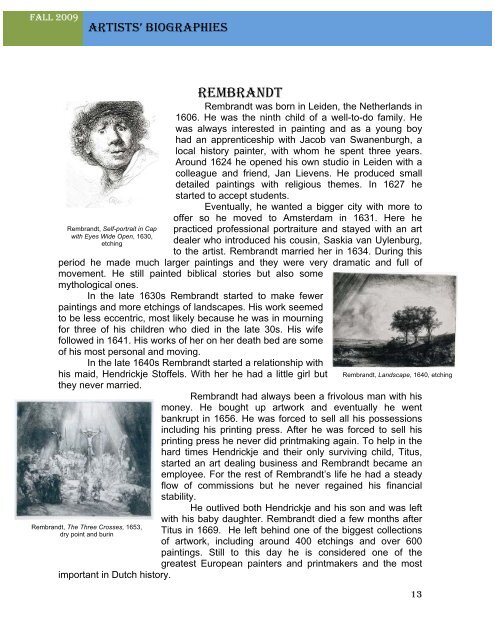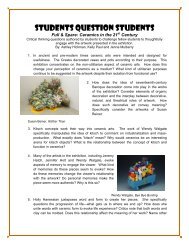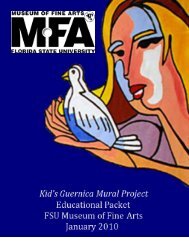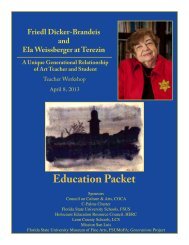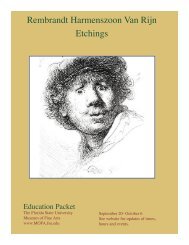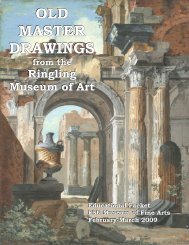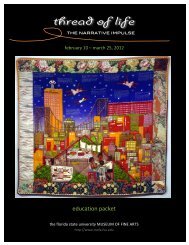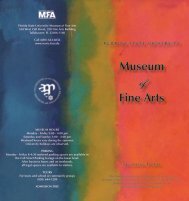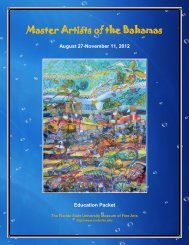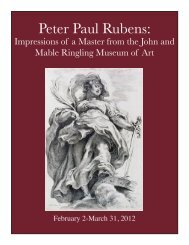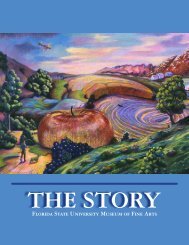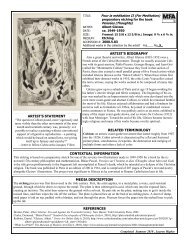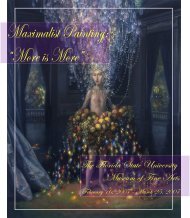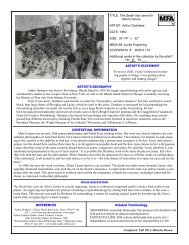Matrix: Contemporary Printmaking - Museum of Fine Arts - Florida ...
Matrix: Contemporary Printmaking - Museum of Fine Arts - Florida ...
Matrix: Contemporary Printmaking - Museum of Fine Arts - Florida ...
You also want an ePaper? Increase the reach of your titles
YUMPU automatically turns print PDFs into web optimized ePapers that Google loves.
Fall 2009<br />
Artists’ Biographies<br />
Rembrandt, Self-portrait in Cap<br />
with Eyes Wide Open, 1630,<br />
etching<br />
Rembrandt, The Three Crosses, 1653,<br />
dry point and burin<br />
Rembrandt<br />
Rembrandt was born in Leiden, the Netherlands in<br />
1606. He was the ninth child <strong>of</strong> a well-to-do family. He<br />
was always interested in painting and as a young boy<br />
had an apprenticeship with Jacob van Swanenburgh, a<br />
local history painter, with whom he spent three years.<br />
Around 1624 he opened his own studio in Leiden with a<br />
colleague and friend, Jan Lievens. He produced small<br />
detailed paintings with religious themes. In 1627 he<br />
started to accept students.<br />
Eventually, he wanted a bigger city with more to<br />
<strong>of</strong>fer so he moved to Amsterdam in 1631. Here he<br />
practiced pr<strong>of</strong>essional portraiture and stayed with an art<br />
dealer who introduced his cousin, Saskia van Uylenburg,<br />
to the artist. Rembrandt married her in 1634. During this<br />
period he made much larger paintings and they were very dramatic and full <strong>of</strong><br />
movement. He still painted biblical stories but also some<br />
mythological ones.<br />
In the late 1630s Rembrandt started to make fewer<br />
paintings and more etchings <strong>of</strong> landscapes. His work seemed<br />
to be less eccentric, most likely because he was in mourning<br />
for three <strong>of</strong> his children who died in the late 30s. His wife<br />
followed in 1641. His works <strong>of</strong> her on her death bed are some<br />
<strong>of</strong> his most personal and moving.<br />
In the late 1640s Rembrandt started a relationship with<br />
his maid, Hendrickje St<strong>of</strong>fels. With her he had a little girl but<br />
they never married.<br />
Rembrandt had always been a frivolous man with his<br />
money. He bought up artwork and eventually he went<br />
bankrupt in 1656. He was forced to sell all his possessions<br />
including his printing press. After he was forced to sell his<br />
printing press he never did printmaking again. To help in the<br />
hard times Hendrickje and their only surviving child, Titus,<br />
started an art dealing business and Rembrandt became an<br />
employee. For the rest <strong>of</strong> Rembrandt’s life he had a steady<br />
flow <strong>of</strong> commissions but he never regained his financial<br />
stability.<br />
He outlived both Hendrickje and his son and was left<br />
important in Dutch history.<br />
Rembrandt, Landscape, 1640, etching<br />
with his baby daughter. Rembrandt died a few months after<br />
Titus in 1669. He left behind one <strong>of</strong> the biggest collections<br />
<strong>of</strong> artwork, including around 400 etchings and over 600<br />
paintings. Still to this day he is considered one <strong>of</strong> the<br />
greatest European painters and printmakers and the most<br />
13


